Dosa is soul food for me. I often tell The Husband how I can make and eat dosa every day for a long time and still not be bored with it. It’s probably because we ate a lot of dosa growing up. Our family, or rather the Reddiar community in Kerala, always has homemade dosa batter in the fridge, ready to whip up fresh dosas on demand or for the unexpected guests whom we always insist stay for dinner.
My mom has been using an industrial sized wet grinder for many years now and it is run about twice a week to keep the idli/dosa batter supply ongoing and fresh. We make idlis as soon as the batter ferments and then dilute the batter further to make dosas for the next 3-4 days. Dosa also needs batter that’s more fermented and sour than idlis.
Check out this post for all tips and trips on how to make soft idlis with idli batter. Also check out barnyard millet dosa recipe.
I use a table-top wet grinder for making dosa batter, pictured below. It’s the brand Ultra and has served me well now for 10+ years. It makes enough batter for a small family of four to last 4-5 meals and is perfect for us. Remember to use skinned, whole white urad dal and specific idli or dosa rice to make dosa batter at home.
About Dosa
Dosa is arguably the most popular South Indian breakfast recipes, with its own variations and recipes used and passed down from generations. The way we make the batter is very simple and uses only two ingredients apart from salt – whole urad dal and par-boiled rice. There are certain versions of dosa batter that include aval or poha (flattened or beaten rice), fenugreek seeds, cooked rice, etc. We do none of that and just reply on urad dal : rice in 1 : 3 ratio.
The dosa batter recipe can be scaled easily but if you use 1 cup urad dal and 3 cups rice, that is enough to make dosas for a family of four for 2 meals approximately.
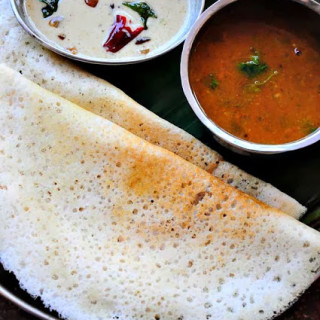
Plain Dosa Recipe With Homemade Dosa Batter
Ingredients
For the dosa batter
- 1 cup whole, skinned urad dal
- 3 cups par-boiled rice stores sell this as Idli rice too
- 1 tablespoon Salt
To make dosas
- 4 cups of fermented dosa batter
- 1 cup of water more or less
- 4 tbsp of gingelly oil Indian sesame oil
Instructions
To Make Dosa Batter
- Soak the rice and dal separately for 3 hours
- Grind dal first into a smooth consistency adding enough water
- Grind rice into a smooth batter by adding just enough water to get it going
- Combine the two, add salt, and let it ferment in a large enough bowl lightly covered, for about 6-8 hours in a warm place
- * You can increase rice to four cups if using good quality urad dal but it takes experience and practice to tell if that’s the case so go with these proportions as you start out
To Make Dosa
- Add enough water to the fermented batter until you have a smooth, pouring consistency. Make sure the batter is not too watery though, it should be thick-ish but fall off your spoon easily.
- Heat a tawa or iron griddle and grease with the oil lightly. Pour about 1/2 cup batter to the centre of the tawa.
- Using the back of your ladle, gently spread the batter with a circular motion from the centre towards the sides of the tawa.
- This requires some practice but is not hard at all. As you can see, I have made dosas enough times to actually do a decent job with my left hand while taking pictures with my right. Ok, I’ll stop showing off now.
- Since we are not making very crispy dosas, don’t spread it too thin. The dosa should be more or less evenly thick.
- Drizzle about 1 tsp of oil around the edges of the dosa and add a few sprinkles on the top as well.
- If your tawa is greased adequately and is not sticky, the edge of the dosa will start to come off the pan in about 1 minute or so. Use a spatula to gently lift the dosa
- and flip it over. Cook the other side for another 40 seconds or so and remove from pan.
- Serve with dosa podi, chutney, sambar, tiffin sambar, or anything that takes your fancy. I can eat dosa with pretty much anything!
Step by Step Pictures to Make Dosa:
1. Add enough water to the fermented batter until you have a smooth, pouring consistency. Make sure the batter is not too watery though, it should be thick-ish but fall off your spoon easily.
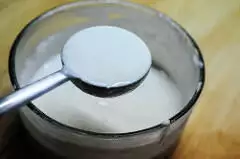
2. Heat a tawa or iron griddle and grease with the oil lightly. Pour about 1/2 cup batter to the centre of the tawa.
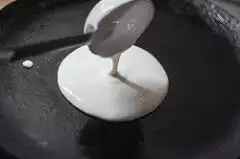
3. Using the back of your ladle, gently spread the batter with a circular motion from the centre towards the sides of the tawa.
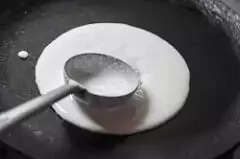
This requires some practice but is not hard at all. As you can see, I have made dosas enough times to actually do a decent job with my left hand while taking pictures with my right. Ok, I’ll stop showing off now.
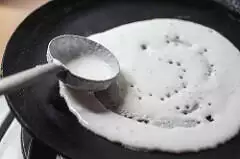
Since we are not making very crispy dosas, don’t spread it too thin. The dosa should be more or less evenly thick.
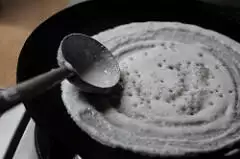
4. Drizzle about 1 tsp of oil around the edges of the dosa and add a few sprinkles on the top as well.
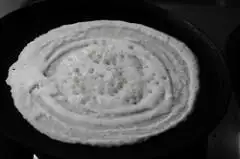
5. If your tawa is greased adequately and is not sticky, the edge of the dosa will start to come off the pan in about 1 minute or so. Use a spatula to gently lift the dosa
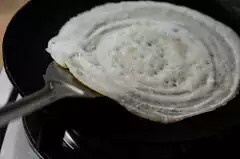
and flip it over. Cook the other side for another 40 seconds or so and remove from pan.
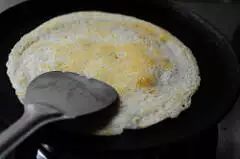
Serve with dosa podi, chutney, sambar, tiffin sambar, or anything that takes your fancy. I can eat dosa with pretty much anything!
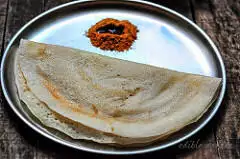
Notes and FAQs
Q: Why does my dosa stick to the pan?
A: There are a few reasons for this:
1. The pan – use a well-greased pan – if your tawa is new, you need to season it to make sure it’s ready to make dosas. Using a non stick pan works but in my opinion, the dosas turn out dry. Use a pre-seasoned iron tawa and you will be fine.
To grease a dosa pan properly, use anything you can dip into oil – like a piece of onion, potato, a wooden spoon, etc. Dip into the sesame oil and rub generously all over the pan. If you pour drops onto the pan, then spreading the dosa will be difficult so always grease fully and don’t pour the oil before spreading dosa.
2. Keep it exclusive – never use a dosa tawa to make chapatis or anything else. Keep one pan exclusively for dosa. I have noticed that people who are new to making dosas add way too little oil. Be generous, a few drops are not enough.
3. Batter has too much water – this makes cooking times longer. If you have more fermented thick batter in stock, add it to the batter you are using, or, just lower flame and be patient. Make sure your flame is not very high. Medium-low heat is perfect for cooking dosas and you may need to adjust this on and off as the pan gets hot and cold during the cooking process.
If the above reasons are checked, then it’s possible that your batter is too old and sour. That’s another reason why it would stick to the pan.
Q: Why is my dosa batter grainy?
A: You didn’t grind the batter to a smooth consistency, that’s why. Remember to soak the rice and dal for enough time and grind it to a very smooth consistency before fermenting. An Indian mixie or a good blender is enough to make small quantities but a food processor likely won’t give you a smooth batter. A wet grinder is obviously the best option for making dosa batter at home.
Q: My dosa is white even after it is cooked. Why?
A: Couple of reasons that could be contributing to this – your batter is too cold – just bring it to room temperature before making the dosa – or, the proportion of rice in your batter is too high. Adjust proportions next time you make the batter. Conversely, too much dal in your dosa batter will contribute to dosas that are too red in colour. Adjust accordingly in your next batch.
Q: My dosas are very sour. Why?
A: Your batter is over-fermented or too old. If you have some wheat flour (atta), add it to the old batter and make semi-wheat dosas. Another trick is to add equal amounts of fresh batter and make dosas. Masala Paniyaram is another way to use up old dosa batter.
Q: How much salt should I add to the dosa batter?
A: I actually don’t measure salt each time but noticed that I end up adding a heaped teaspoon of salt to the 1 cup dal and 3 cup rice proportion of batter. You can taste the batter and see if it seems salty enough. Adding enough salt is important for right amount of fermentation.
Q: How do I ferment dosa batter in a cold place?
A: The most fail-proof method is to use your oven if you have one. Keep the batter covered in a bowl and turn the oven on about 40C and leave overnight. This will ensure your batter gets enough warmth to ferment.
If you don’t have an oven, leave in the warmest part of your home or near a source of warm heat (not direct heat) or in a heated room.
Q: How do I use store-bought dosa/idli batter?
A: The quality of store-bought batter really varies a lot. I have tried a few different brands in Singapore and have had different experiences. One thing that’s common is, although they all claim to also make good idlis, they don’t. So don’t waste your time making idlis with store-bought batter. Dosas, however, have turned out good for me. Most batters need you to add some water to bring it to the right consistency. Use up all batter within 3 days, they don’t last as much as homemade batter.
They also freeze well even if the package says not to freeze dosa batter.
Q: What about variations to the dosa batter – like adding poha, cooked rice, quinoa, brown rice, etc?
A: I make dosa batter the plain and simple way as mentioned above. I do plan to experiment a bit though but be patient with me, will share them as I get to it.
Q: Can I freeze dosa batter? How do I do that?
A: Yes! I make double batches often and freeze half the batter. You need to make the batter, let it ferment and then transfer the necessary quantity to an airtight container and pop in the freezer. When you need to use it, thaw in the refrigerator for a few hours or overnight. Add water as needed and voila! Your dosa batter is as good as new.
Since dosa batter in the fridge can turn sour after a few days, freezing is an excellent way to make more batter in one go and save some for fresh dosas at a later time.
If you have any more questions on making dosa at home, please leave it below in the comments and I will get back to you. Between my mom and me, we should be able to answer them 🙂 The above questions were compiled after a short poll I did on my Facebook page and hopefully they represent most of your personal questions on making dosa at home.
If you found this post useful, please pin it or share it with friends. Thanks!

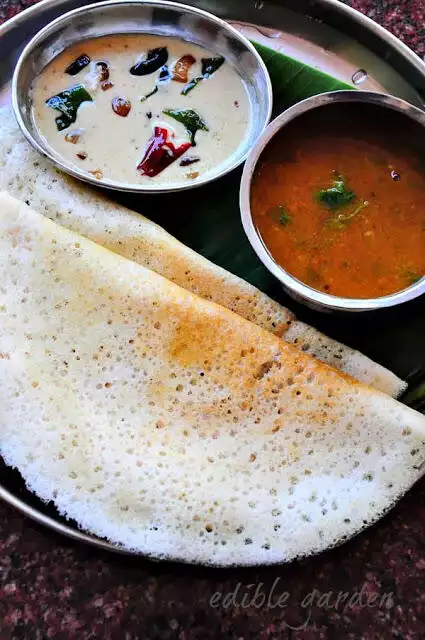
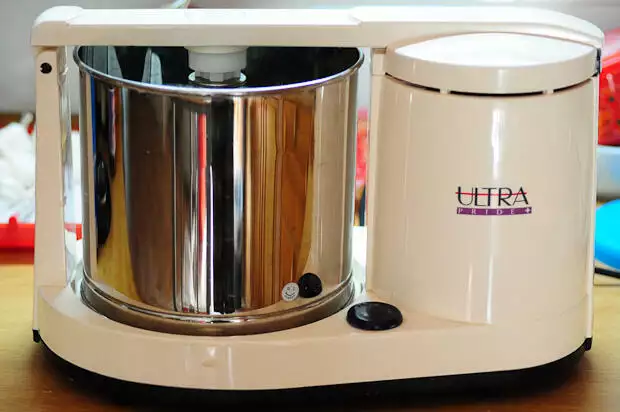
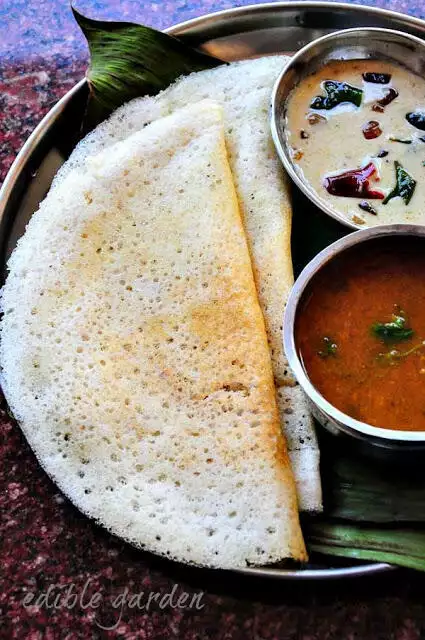
Hi I have leftover of dosa that I ordered from a restaurant. Can I store it in fridge, reheat and eat it next day?
leftover dosa really doesn’t taste good. your best bet is to steam it the next day, that will make it as soft as it will get but be warned, stale dosa is really not tasty.
I try to add few methi seeds while soaking the rice n grind. I guess this will give a brown coating for the dosa.
i add that sometimes too. also gives a nice flavour to the dosas
Sunday i made dosa and it turned out perfect. But tuesday when i am using the same batter its sticking to the iron tava. Is it because i kept it in fridge for 2 days.
Hello Nags, I love all the vegetarian recipes on your website! What a great resource for all my South Indian favorites.
My favorite recipes are the Pulissery, Olan and Cabbage Thoran.
I have two questions:
1} Do you have a recipe for Pulinkari?
2) Can I mix old and new dosa maavu together to consolidate pathrams? Or will the old maavu ruin the New batch?
Thank you!
hi SB! yes, i do have a recipe for pulinkari somewhere, just checking if you mean the theeyal variety? different parts of kerala call dishes differently I find 🙂
you can mix the old batter with a small batch of the new batter but not entirely. it will make the new batter go stale quicker. my recommendation is not to mix, if you can help it but sometimes if i only have about 1-2 cups left, i mix the old batter with same amount of new batter and finish it within that one meal time.
Hello young lady,
can u pl,explain how to do season on cast iron step by step?
is it ok i if i buy pissa cast iron from amazon to make dosa?
do u put salt in batter before or after fermentation?
when i make dhosa on non stick tava, it comes out dry, even though i do put oil around dhosa and middle of dhosa?
pl, advice.
salt after or during grinding and before fermentation. it aids in the fermentation process.
non stick tawa doesn’t work the best for making dosa. You need to regulate the heat carefully and constantly and make sure the batter is not spread too thin, otherwise the dosa will turn try. Try to get a cast iron or regular stone dosa tawa if you make them regularly
Im v upset as I invited some friends for Dosa party but I made a paste of 2 cups Parboil rice with 1/2 cup urad daal.but its crunchy but hard to take out from Dosa gridle.I always make the best Dosa with Plain Rice.Is it wrong to Use Parboil rice?
Typically, idli or dosa batter rice is par boiled so that shouldn’t be the issue. maybe you need to try rice : urad dal in 3:1 ration instead of 4:1.
Hello… its a very useful article. Thank you. Just have one qn. How long can we store the batter in the refrigerator?
up to 4 days is good. beyond that the batter will start turning very sour
very detailed and useful info. Thanks for spreading knowledge.
Thank you!
Very good write up. I liked it and git encouragement to attwmpt
thank you so much!